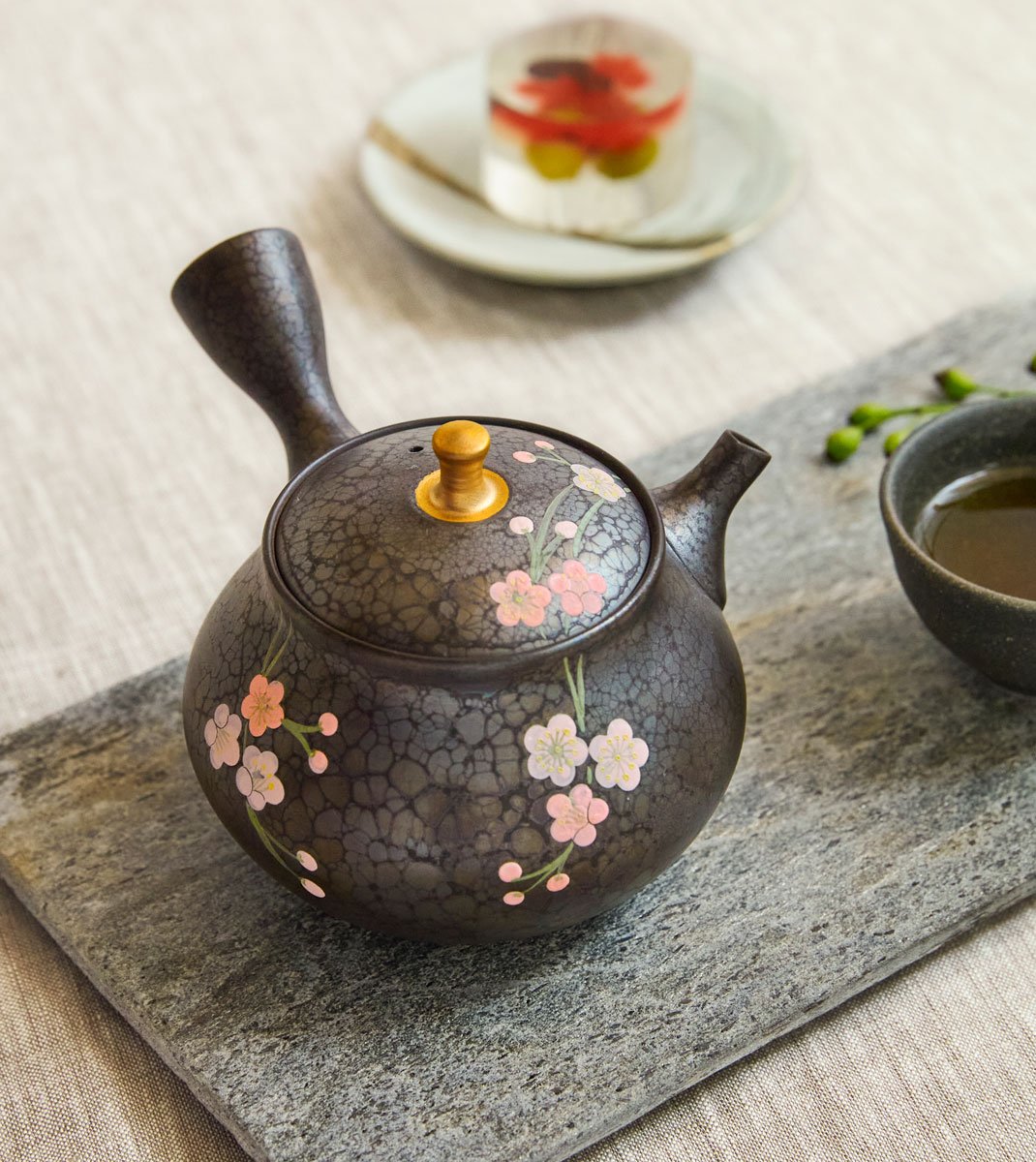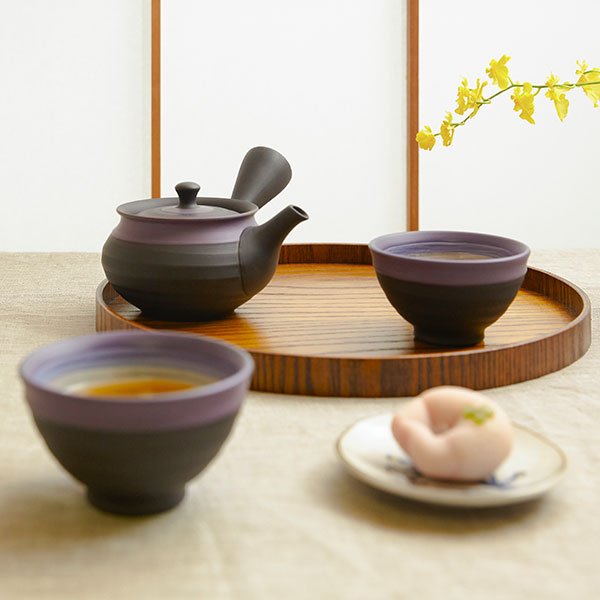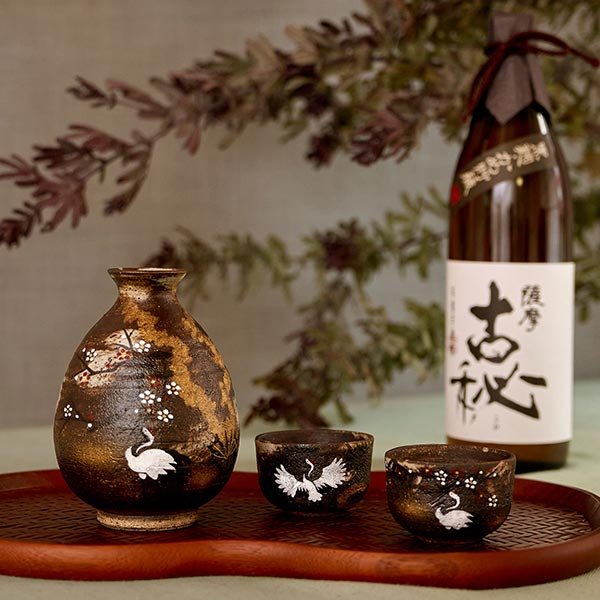Kyusu: Choosing the Best Traditional Japanese Teapot
by Anne Walther | CRAFT
Tokoname Kyusu Teapot Set by Ukou, available at Japan Objects Store
Green tea has a long tradition in Japanese culture and is deeply incorporated into people’s daily life. Still common today, the ancient practice of the Japanese tea ceremony involves a ritualistic preparation of green tea, while of course Japanese people drink and enjoy green tea in a less formal way throughout the day. But whichever way you’re enjoying the drink yourself, the kyusu teapot is the perfect daily companion for brewing Japanese tea.
1. What is a Kyusu Teapot?
Red Clay Kyusu Teapot, available at Japan Objects Store
Kyusu (急須) are traditional Japanese teapots mainly made of fired volcanic clay of very high quality. The word kyusu simply means teapot, even though in common usage kyusu usually does refer to a teapot with a side handle.
They originally came from ancient China and have been naturalized into Japanese culture over the centuries for the preparation of Japanese green tea. Kyusu are usually smaller than a western teapot, around 100-300 ml (3-10 fl. oz) is common. A teapot with a volume of more than 300ml (10fl. oz) is perfect for several guests.
The green tea leaves are brewed loose in the pot with plenty of room to develop their aromas and flavors. The spout incorporates a clay or metal filter to retain the tea leaves when pouring.
2. Where did Japanese Teapots Come From?
© Chashitsu_LaSere / Creative Commons, Yi-Xing Chinese Teapot
The creation of the side-handle kyusu (yokode kyusu) took place in China during the Song Dynasty (960-1279). This teapot was used for the preparation of powdered green tea. It is still used today for herbal infusions, which are very common in China.
The precious red Yi-Xing clay was used in China to make pottery, but because of its high mineralization, it was also used to soothe the skin and stop bleeding from open wounds.
Shibata Zeshin (1807–1891), Plum Branch and Teapot, Folding fan, lacquer on paper, Meiji period (1868–1912). MET, New York.
The poet, monk and calligrapher Ingen Ryuki (1592-1673), who established the Obaku school of Zen in Nagasaki, is credited with bringing Chinese Yi-Xing teapots and the tradition of loose-leaf brewing to Japan.
Eisen Ikeda, Comparison of Beauty and Feather
A Japanese monk of the Obaku school, Baisao (1675–1763), became famous for selling tea around Kyoto. His method of brewing tea with whole tea leaves placed into a pot of boiling water was referred to as sencha, or simmered tea. This style of tea contrasted with matcha, which was appreciated by monks, samurai warriors and Japanese royalty at that time. Baisao is regarded as the founder of the senchado (way of sencha). Find out more about matcha with 10 Surprising Facts You Didn’t Know about Matcha Tea.
Some of the first Japanese kyusu were created by Aoki Mokubei (1767-1833), an art lover, potter and painter, with a passion for Chinese culture.
These days some of the best Japanese kyusu come from the region of Tokoname, near the city of Nagoya. Read our article to find out why Tokoname-Yaki is the best in it's class!
3. What are Kyusu Teapots Made Of?
Plum Kyusu Teapot by Shoryu, available at Japan Objects Store
The most luxurious kyusu teapots are produced by hand, with mineral-rich clay that often comes from volcanic regions. Despite their sometimes high prices, green tea enthusiasts swear by the taste they impart to the tea. Moreover, a kyusu takes on a patina over time: the tea brewed in it gains in quality. These traditional Japanese teapots are therefore highly appreciated for the positive (but rather light) effect they have on the flavor of green tea.
Clay, a highly mineralized material, reacts with the minerals contained in hot water during infusion. Each type of clay contains varying levels of iron, zinc, copper, chromium, manganese and so on. However, the manufacturing process also has an influence on the taste of the green tea. For example, black clay contains a lot of manganese, which is revealed by firing the kyusu. The most important factors are the iron content of the clay, the firing temperature and the level of oxygen saturation during firing. These factors are responsible for iron activation. Consequently, two teapots of similar appearance can have different effects on the taste and properties of green tea. Moreover, the shape of the teapot has a direct impact on how the tea leaves unfold and how the water cools down.
Orchid Kyusu Teapot by Shoho, available at Japan Objects Store
Highly-skilled craftsmen, sometimes the descendants of generations of master potters, are able to produce different types of kyusu by hand with various types of clays. The most famous types of Japanese earthenware for kyusu teapots are Banko-yaki from Yokkaichi, Mie prefecture and Tokoname-yaki from Tokoname, Aïchi prefecture. The translation of yaki being "to burn/cook". An interesting fact: their locations correspond to the passage of the Japan Median Tectonic Line which is responsible for the exceptional mineralization of the soils. If you’re interested to learn more about these locations, check out the 6 Best Japanese Ceramic Towns You Should Visit. You can even try your own hand at potter with these 8 Best Ceramic Classes in Japan for English Speakers.
The most illustrious family of master potters from Tokoname is the Yamada family. Yamada Jozan III (1924-2005) was named a Living National Treasure in 1998 and received this highly honorific distinction for a kyusu. In Tokoname-yaki and Banko-yaki, potters are named kyusu-shokunin, kyusu craftsmen. The making of kyusu is a highly difficult specialty in pottery.
Different regions of Japan specialise in different types of pottery. To find out more, check out our A-Z Guide to Japanese Ceramics!
4. What Types of Traditional Kyusu are There?
Stone Gray Kyusu Teapot by Morimasa, available at Japan Objects Store
The side-handle is one of the distinctive signs of a kyusu. This handle has several advantages over the handle most often found on western teapots. It allows a much greater agility in handling the teapot and is much less restrictive for the wrists, which is useful when the teapot is heavy.
The side-handle is usually placed at 90˚ from the spout. However, there are many variations, as the back-handle kyusu (ushirode kyusu), the top-handle kyusu (uwade kyusu) or even without handle (hohin kyusu).
Red Clay Kyusu Teapot, available at Japan Objects Store
Kyusu can be produced using a potter’s wheel or moulds. In the mould technique, named ikomi, each part of the teapot (body, filter, handle, lid, spout) is made separately and then assembled, smoothed and finished, as for hand-turned teapots.
Whether the kyusu is hand-turned or mould made, the lid is specially adapted. Each teapot is fired with the lid placed on. If you break the lid of your teapot, it is not possible to order a new one. Nevertheless, the Japanese solution of kintsugi repair may your lid a second chance.
5. Clay or Porcelain?
Porcelain Kyusu by Masahiro Mori, 1979, V&A Museum
Porcelain is neutral and has no influence on the taste of the tea, while unglazed earthenware ceramics will all have slightly different properties. However, it is preferable to start with a clay kyusu as there are more clay teapots of high quality than porcelain teapots.
© Christian Kaden / Creative Commons, Kyusu Teapot
Porcelain is, however, suggested for analytical tastings. The hohin kyusu, without handle, is then preferred by tea connoisseurs and enthusiasts. Recommended for teas that are brewed with fairly warm water such as gyokuro, hohin kyusu doesn’t have any handle. Held by the top, the risk of burns is minimal.
6. How to Use a Japanese Teapot?
Pouring Japanese tea
The first option is to use it like a traditional western teapot, using the same quantity of tea leaves and with the same infusion time. This method is ideal for preparing small quantities of high-quality tea while offering the pleasure of using a special teapot.
The second option is the traditional Japanese method to use a kyusu, in which the tea leaves can be infused several times. Infuse the leaves for one minute the first time and a few seconds for the following times.
When serving Japanese tea, it’s preferable to pour a little into each cup, about a third, then repeat until they are all full. This way, all cups have the same flavour and brewing. It is important to pour out all the liquid contained in the kyusu, as otherwise the tea will continue to brew, making the tea leaves unsuitable for a second or third infusion.
Tokoname Kyusu Teapot Set by Ukou, available at Japan Objects Store
After use, the teapot should be rinsed thoroughly with hot water, which will help it to dry faster. Store your tea pot in a well-ventilated area, and do not replace the lid before it is completely dry inside. In particular pay attention to the interior of the spout, which remains wet for a long time.
7. What Types of Japanese Tea Use a Kyusu?
Tokoname Kyusu Teapot Set by Ukou, available at Japan Objects Store
Spring teas with very tender and aromatic leaves can be enjoyed after being used for infusion in a salad with soy sauce or ponzu. Another interesting recipe is to combine the infused tea leaves with rice vinegar, soy sauce and sesame oil. Serve over cooked rice and garnish with sesame seeds.
In summer, it is also possible to prepare iced tea in a kyusu by replacing the water with ice cubes. The infusion is finished when the ice cubes have completely melted: the result is a concentrated and intense liquor.
8. Where Can I Buy a Japanese Kyusu Teapot?
Seagrass Kyusu Teapot by Gyoko, available at Japan Objects Store
If you are looking for a simple kyusu for daily life, you will find various ceramics boutiques strolling around Kyoto’s touristic areas and Asakusa neighborhood in Tokyo. Our advice is to double-check the labels and provenance, as some (unexpensive) kyusu are made in China or Vietnam.
You don’t have to be in Japan to buy an authentic kyusu teapot for yourself. At Japan Objects Store, we work with some of the finest artisans and kilns from Tokoname to bring you handcrafted teapot sets and matcha bowls that you will treasure for years to come!















TRAVEL | April 26, 2024